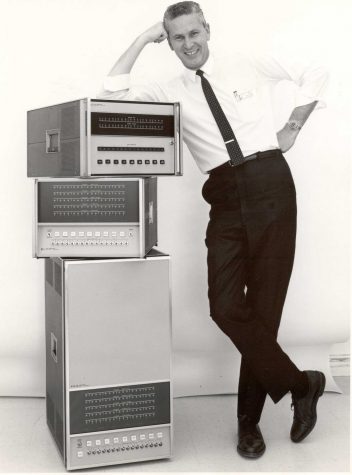Silicon Valley: From fruit trees to computer chips
Graphic illustration by Rachel Wu and Youqi Huang
The valley has gone through a complete transformation in the last 100 years from a primarily agrarian society to an urban region with a high concentration of tech companies.
November 4, 2020
The Silicon Valley we know today had its roots as a primarily agricultural region. Now, it stands as the birthplace of an unique culture of innovation, home to numerous companies in the tech industry regarded as leaders in their field.
While Silicon Valley is often used to refer to the many high-tech companies in the Bay Area as a collective, the geographic area referred to by the term roughly corresponds to Santa Clara Valley, a stretch of land running south-southeast from the southern end of San Francisco.
During the early twentieth century, Santa Clara Valley was known as the Valley of Heart’s Delight because it was home to many fruit orchards, as well as packing and shipping companies. The valley produced cherries, pears and apricots, though its main exports were prunes.
“When I ran track at De Anza College in 1974, the Seven Springs neighborhood was still a big old orchard,” long-time Silicon Valley resident Hank Lawson said. “The Parker Ranch neighborhood didn’t exist either. It was just a ranch, and one of Lynbrook cross country’s favorite places to train, so we were bummed when they put that in. There were more wineries and a vineyard back then as well, and all that’s left is the Heritage Orchard on Fruitvale Avenue.”
The region’s fertile soil made it home to many agricultural industries. Up until the 1960s, Santa Clara Valley was the largest fruit producing and packaging region worldwide.
The entrepreneurial spirit of Silicon Valley can be traced back to Frederick Terman, an electrical engineering professor at Stanford University who would later be widely touted as the father of Silicon Valley. Concerned by the lack of employment opportunities for his engineering graduates, Terman encouraged them to start their own businesses in the Santa Clara Valley rather than head to the east coast for work.
“I think what makes it the most unique is that Stanford has a lot of people who have both the willingness and drive and vision to build a company, but also the technical acumen to do so and to build a product that is really impressive,” said Shan Reddy, a junior at Stanford University interested in entrepreneurship. “I think that having those two things together is rare and is the perfect storm to create a vibrant entrepreneurship community.”
In 1939, Stanford electrical engineering graduates William Hewlett and David Packard would go on to found their own company Hewlett-Packard. The manufacturing company of software and computer services grew into a multinational corporation and is widely considered to be the company that gave birth to the Silicon Valley.
“I remember Stanford not having as much of a reputation for computer science until the late 80’s to early 90’s,” Lawson said. “They started to have some alumni come out and those alumni continued to work with Stanford as venture capitalists to invest in new ideas coming out of the school. Companies like Google came out of that, which helped cement the idea that to be big in computer science, you go to Stanford.”
In the 1950s, the valley found a new purpose for itself as a manufacturer of silicon chips. The “silicon” in Silicon Valley refers to these chips, which are crucial components for transistors.
In 1956, William Shockley, believing that silicon, not germanium — the popular material at the time — was the ideal material for creating transistors, founded Shockley Semiconductor Laboratories in Mountain View. Employees from Shockley went on to establish other companies, such as Fairchild Semiconductor and Intel.
When NASA’s Ames Research Center opened at Moffett Field near San Jose in response to Russia’s success with Sputnik, the only company able to build electronics for the space capsule was Fairchild Semiconductor. The tense nature of the Space Race had the U.S. allocating funding to any technology that seemed like it would help the nation surpass the Soviets.

Compared to established aerospace technology companies, those in the Silicon Valley were more daring with their technology. This period established the risk-taking, innovative culture of Silicon Valley that continues to define companies in the region to this day.
The nickname Silicon Valley first appeared in the 1970s, by reporter Dan Hoefler. Back then, the term was used to refer to the entire Santa Clara Valley, and Hoefler used it in a column he wrote about the valley’s semiconductor industry.
In the 90s, there was an extensive culture of cutting-edge technology surrounding the area as well. Companies that have now faded out of the spotlight, such as Xerox and Intel, were at the peak of their dominance and Apple was on the verge of bankruptcy.
“My father worked at Atari, headquartered in Sunnyvale, so I remember getting all of the games and consoles before they were released,” U.S. History teacher Kyle Howden said. “Games like Centipede, Dig Dug, all of these old video games that you can run on your cell phone now.”
The recent influx of East and South Asian immigrants attracted by the region’s booming tech industry has resulted in increased diversity introduced to the valley.
“When I was growing up 30 years ago, the area around Lynbrook was still a predominantly white community, and I would say in the last 25 years there’s been a huge demographic shift,” Howden said. “It’s reflected in the shops you see and the signage you see, a lot of which now features foreign languages in addition to English.”
Now, Silicon Valley is home to a multitude of major tech companies including Google, Facebook and Apple, revived under the leadership of Steve Jobs in the early 2000s. Infamous for its high concentration of high-tech companies and jobs, Silicon Valley has an astoundingly high total GDP of $275 billion.
“Back in the 70s, the area was not Silicon Valley,” Lawson said. “This was just where HP was and there was not a rush to come to the Bay Area. Nowadays, everybody comes to the Bay Area if they want to make a startup. I know Facebook felt that way — that they had to come to Silicon Valley if they wanted to be successful.”
Silicon Valley has also made its way into pop culture, inspiring the HBO comedy television series Silicon Valley which follows programmer Richard Hendricks who founded a startup company called Pied Piper in the Silicon Valley. The show not only captured fans with its comedy, but also the startup culture of Silicon Valley as the main character struggles to maintain his company while competing against larger entities.
“The challenge is that building a startup is a battle everyday,” Reddy said. “It’s a learning process. It requires an incredible amount of hustle and grit and passion and vision. However, with that said, even if you have a fantastic product and a fantastic technical team, that might not be necessarily enough to find a niche in the market where you can build a valuable business. So [startups] are a tough thing to do, but if you can pull it off, you can produce incredible outcomes, the likes of which have never been seen in business before.”
From its humble beginnings as orchards of fruit trees to becoming the hotspot of innovation, engineering talent and entrepreneurship, Silicon Valley and its influence is undoubtedly recognized around the world. Its risk taking, inventive spirit will continue to inspire generations to come.





























































